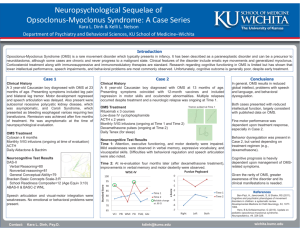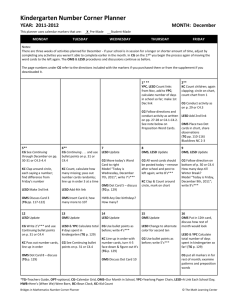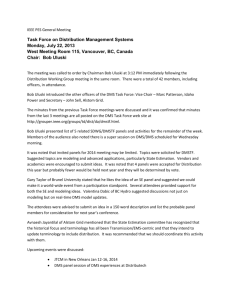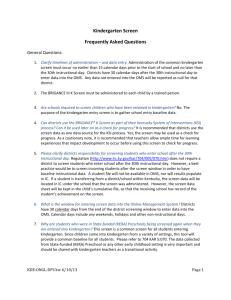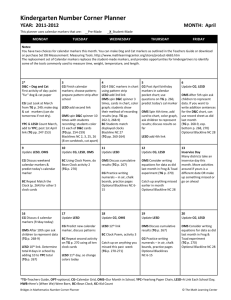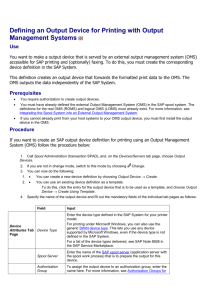Context Free Progress Report 4
advertisement
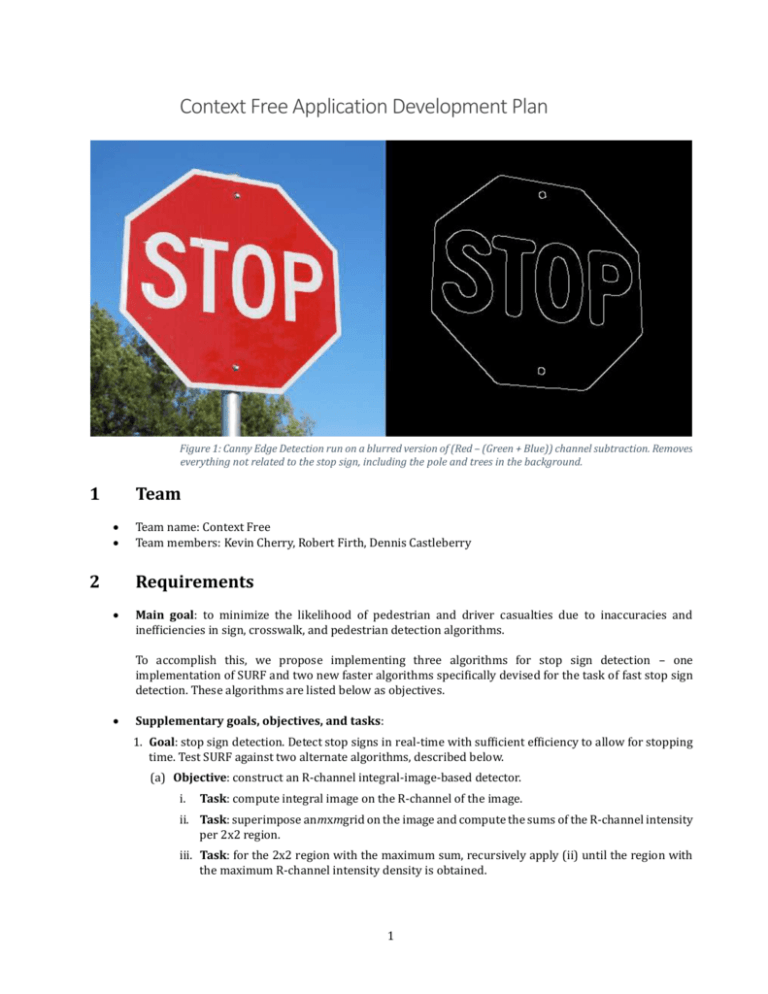
Context Free Application Development Plan Figure 1: Canny Edge Detection run on a blurred version of (Red – (Green + Blue)) channel subtraction. Removes everything not related to the stop sign, including the pole and trees in the background. 1 Team 2 Team name: Context Free Team members: Kevin Cherry, Robert Firth, Dennis Castleberry Requirements Main goal: to minimize the likelihood of pedestrian and driver casualties due to inaccuracies and inefficiencies in sign, crosswalk, and pedestrian detection algorithms. To accomplish this, we propose implementing three algorithms for stop sign detection – one implementation of SURF and two new faster algorithms specifically devised for the task of fast stop sign detection. These algorithms are listed below as objectives. Supplementary goals, objectives, and tasks: 1. Goal: stop sign detection. Detect stop signs in real-time with sufficient efficiency to allow for stopping time. Test SURF against two alternate algorithms, described below. (a) Objective: construct an R-channel integral-image-based detector. i. Task: compute integral image on the R-channel of the image. ii. Task: superimpose anmxmgrid on the image and compute the sums of the R-channel intensity per 2x2 region. iii. Task: for the 2x2 region with the maximum sum, recursively apply (ii) until the region with the maximum R-channel intensity density is obtained. 1 iv. Task: in the neighborhoods of the vertices inside the maximum-density region, find the four box such that the diagonal along those boxes separates a maximum-density R-channel triangle from a minimum-density R-channel triangle. v. Task: obtain the 8 vertices of the sign from the above. (b) Objective: construct octagon detector. – Task: apply a shape detector to yield sets of vertices. – Task: discard all sets where n6= 8. – Task: check to see if the opposing edges of the 8-vertex shape are parallel (within a certain threshold). 2. Goal: pedestrian crosswalk sign detection. (a) Objective: construct and RG-channel integral-image-based detector. i. Task: compute integral image on the R-channel of the image. ii. Task: superimpose anmxmgrid on the image and compute the sums of the R-channel intensity per 2x2 region. iii. Task: for the 2x2 region with the maximum sum, recursively apply (ii) until the region with the maximum R-channel intensity density is obtained. iv. Task: in the neighborhoods of the vertices inside the maximum-density region, find the two boxes such that the diagonal along those boxes separates a maximum-density RG-channel triangle from a minimum-density RG-channel triangle. v. Task: obtain the 3 vertices of the sign from the above. 3 Design Classes in namespace OMS.CVApp.SignDetector SurfStopSignDetector, IntegralImageStopSignDetector, OrientedSurfStopSignDetector are concrete implementations of the StopSignDetector class. Likewise, HogPedestrianDetector is an implementation of the abstract PedestrianDetector class. Both StopSignDetector and PedestrianDetector are subclasses of Detector. Modules 1. Input module: a) No input module. All of our detector code assumes data is already loaded into an Emgu.CV.Image<Bgr, Byte>. 2. MS.CVApp.SignDetector.SURFStopSignDetector a) Functionalities: Implementation of a stop sign detector using a SURF implementation provided by EmguCV. b) Outputs: Array of System.Drawing.Rectagles, each rectangle containing bounds of detected stop sign 3. Also using classes OMS.CVApp.Detector, OMS.CVApp.SignDetector.StopSignDetector, OMS.CVApp.SignDetector.StopSignDetectorA OMS.CVApp.SignDetector.IntegralImageStopSignDetector: a) Functionalities: computes and uses integral image on the R-channel to find maximum density areas used to approximate the region occupied by the stop sign. b) Outputs: Array of System.Drawing.Rectagles, each rectangle containing bounds of a detected stop sign 2 c) Data structures: 4. Namespaces: EmguCV.CV. Classes (Image) and class members: Resize(), Convert(), Also using classes OMS.CVApp.Detector, OMS.CVApp.SignDetector.StopSignDetector, OMS.CV.AppStopSignDetectorA OMS.CVApp.SignDetector.OrientedSurfWarningSignDetector: a) Functionalities: detects a warning sign, determines its orientation, rotates the warning sign models, and finds a match using SURF. Used to extend the robustness to out-of-plane rotation. b) Outputs: Array of System.Drawing.Rectangles, each rectangle containing bounds of a detected warning sign c) Data structures: Image, LineSegment2D, boxList, triangleList, Contour Namespaces: EmguCV.CV. Classes (Image, Contour) and class members: Canny(), HoughLinesBinary(), Resize(), Convert(), PyrUp(), PyrDown(), FindContours(). Also using classes OMS.CVApp.Detector, OMS.CVApp.SignDetector.WarningSignDetector, OMS.CVApp.SignDetectorOrientedSurfWarningSignDetector 5. OMS.CVApp.HogPedestrianDetector: a) Functionalities: detects pedestrians using built-in EmguCV classes. b) Outputs: Array of System.Drawing.Rectangles, each containing the bounds of a detected pedestrian c) Data structures: System.Drawing.Rectangle[]. 6. 4 Namespaces: EmguCV.CV. Classes (Image, HOGDescriptor) and class members: Draw(), SetSVMDetector(), DetectMultiScale(), GetDefaultPeopleDetector(). Also using classes OMS.CVApp.Detector, OMS.CVApp.PedestrianDetector, OMS.CVApp.HogPedestrianDetector OMS.CVApp. a) Functionality: Implements the main app. Implements the Abstract Factory design pattern to switch between implementations of algorithms to allow us to compare accuracy. b) Inputs: Static images, camera stream, or saved video. c) Outputs: Annotated images or streams of images. Data We will capture video from areas dense in pedestrian crosswalk and child crossing signs in a variety of weather conditions (normal weather, nighttime, light and heavy rain); then segment the video to isolate the target objects. We require two data sets; one to explore existing implementations and make incremental improvements, and a second to test the improved implementation. 3 5 Implementation Plan and Timeline Setup project Implement User Interface Implement class hierarchy Implement SurfStopSignDetector Implement IntegralImagesStopSignDetector Implement OrientedSurfStopSignDetector Implement HogPedestrianDetector Compare methods Testing Documentation 10/19 10/22 10/23 10/26 11/20 11/13 10/26 11/27 ongoing ongoing 4 Done Done Done Done User Interface Figure 2: Stop sign detection run on pre-recorded video for OMS.CVApp.SignDetector.StopSignDetectorA 5 Figure 3: Stop sign detection run on live video, using OMS.CVApp.SignDetection.StopSignDetectorA 6 Figure 4: Stop sign detection run on a static image, using OMS.CVApp.SignDetection.StopSignDetectorA 7 Appendix Figure 5: Edge detector by computing R-(G+B), clamped from 0 to 255 Figure 6: Edge detector by computing R-(G+B), clamped from 0 to 255 8
